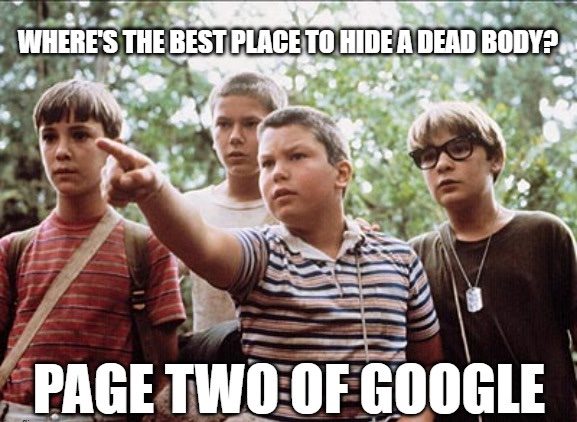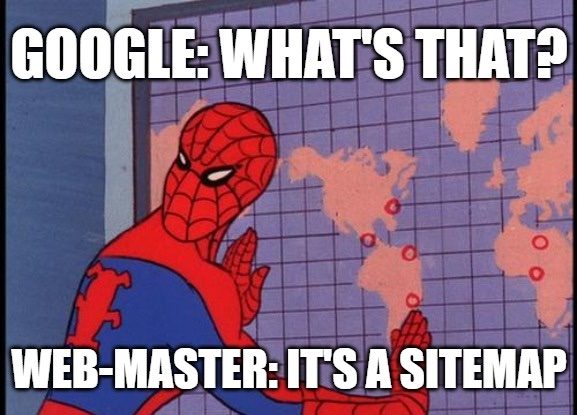Top 8 Vital SEO Ranking Factors | SEO Isn’t Wizardry!
by Joseph Jones • April 28, 2023
If you’re thinking “I’ve heard SEO is important, I’ll try to get around to it,” you need to light a fire under that and make it a priority!
[just imagine a fire blazing under your feet right now; there’s no emoji for this]
The vast majority of people research products and services online before they make a purchase or call to get services. You can’t afford to not show up when those searches are happening. SEO isn’t optional anymore, it’s imperative, and knowing what affects SEO is the best way to improve yours!
Being on page one of Google for a search term is not only incredibly satisfying, but its importance can’t be overstated. In fact, according to a study published by Poll the People, Page one results get 95% of clicks to websites.
That means that even though page two is pretty good, only 5% of searchers even look on page two or beyond. Pretty staggering-which is what gave rise to one of the most popular Google jokes ever:

So, whether you’re a fairly seasoned SEO specialist, or a greenie who simply knows that SEO is important but involves some wizardry (not true), you have come to the right place to brush up on your basics or dive deeper into the top SEO ranking factors to get your site on track!
In this article, we’ll discuss the top Google ranking factors and how they can impact your site and your business. We’ll also include a Glossary of SEO terms to help you stay current with online trends and vocabulary.
Let’s get started!
SEO Content Focusing on Human Users
If you’re tired of hearing that content is king, you might want to cover your ears. Content is still what informs Google about your site’s credibility the most. That is probably because it is evaluated for several metrics–the ones included in the E-E-A-T guidelines.
Google prefers sites that have quality content that highlights experience, expertise, authoritativeness, and trustworthiness.
How Google evaluates and grades for these metrics is not 100% clear, but making sure your content is clear, unbiased and informative is always better than serving up agenda-ridden writing that doesn’t educate. As far as your site is concerned, you are what you E-E-A-T!
Search engines will crawl your site to find relevant keywords, but they will also use intuitive and semantic search, meaning that they don’t give preference to sites that “stuff” their keywords, but are looking for intent within the search query and the results they serve up.
Stuffing keywords is an outdated black hat practice that over-uses a keyword so it can show up for site-crawling bots. It usually ends up making content sound super lame and inauthentic. Google, however, got smart to this nonsense and now can detect when content sounds organic and meaningful vs. repetitive and hollow.
Remember, content is supposed to be written for people, not just search engine bots. This is what search engines are starting to look at more and more. Also, be mindful about writing content through AI software like ChatGPT. It’s not always fruitful to use a machine for what a human can do.

Search engines are looking for content that is informative, states real and verifiable facts, and relates to relevant topics. For example, if your content is about financial planning, and mentions related topics like retirement planning, investments and estate planning, Google interprets that as relevant and authoritative.
Page Speed
Nothing is more annoying than excessive load time when you are in a hurry to find something on a particular website or search. And by “excessive load time,” we mean anything more than 3 seconds! Listen, we are all busy and we just don’t want to wait for a page to finish “spinning.”
Google gets it, and since Google’s number one concern is user experience, load time is at the top of the list for UX concerns. This is also part of the Core Web Vitals (CWV) that will be covered next.
Improving the load speed of your website is essential to providing that great user experience Google loves to reward. There are several things you can do to achieve this. Here are some suggestions:
- Optimize images: Large image files can slow down your website. Ensure that images are optimized by compressing them and reducing their file sizes.
- Minify CSS and JavaScript: Minifying your CSS and JavaScript files by removing unnecessary characters, such as white space, can help reduce file size and speed up loading times.
- Use a content delivery network (CDN): A CDN can help distribute your website’s content across multiple servers, reducing the time it takes to load your website. Sometimes, this isn’t always in your best interest because CDNs don’t always include alt text for images. Be mindful of the CND you’re using.
- Enable caching: Caching allows a website to store frequently accessed information, such as images or page content, on a user’s device. This reduces the need for the website to fetch the same content repeatedly, speeding up load times.
- Reduce HTTP requests: Minimizing the number of HTTP requests that your website makes can help speed up page loading times. This can be achieved by reducing the number of resources required to load each page, such as images, scripts, and stylesheets.
- Use a fast web host: Your web host can have a significant impact on the speed of your website. Choose a reliable host with fast servers.
- Optimize your code: Optimize your code by reducing the number of lines, using efficient algorithms, and removing redundant code.
- Use a lighter theme or template: Heavy themes with lots of elements can slow down a website’s load time. Choose a lightweight theme that prioritizes speed and performance.
Be sure to use the Google tools covered in the CrUX report for checking on site speed and other factors that create best UX.
User Experience
It’s no secret that good user experience (UX) is imperative to keeping people engaged with and returning to your site. Poor user experience is not only off-putting to your visitors, but can actually be penalized by Google. A good place to check in with how your site is measuring up to Google’s standards is the Chrome User Experience Report (CrUX). There, you can gain valuable insights into what is affecting the SEO on your particular site.
Another great resource is actually a subset of the CrUX report called the Core Web Vitals (CWV). These are essential to monitor and are part of all Google reports. The CWV metrics deal with things like site speed, visual stability and interactivity.
Making sure you’re hitting the mark in terms of Google’s expectations will help you to rank higher and avoid being penalized. Here is a brief explanation of the three main measurements to be aware of:
1. Loading Speed
One of the most critical Core Web Vitals is loading speed, which measures how quickly a page’s main content loads. A slow-loading website can lead to a poor user experience, resulting in higher bounce rates and lower engagement. In turn, this can negatively impact your SEO ranking. Google recommends that websites aim for a loading speed of 3 seconds or less.
2. Interactivity
Interactivity measures how quickly users can interact with a website’s content. This includes actions such as clicking on buttons and links, scrolling, and entering information into forms. Slow interactivity can lead to frustration and a poor user experience. Google recommends that websites aim for an interactivity score of 100 milliseconds or less.
3. Visual Stability
Visual stability measures how stable a website’s visual content is as it loads. For example, if images or videos shift around as a page loads, it can be frustrating for users and negatively impact the user experience. Have you ever clicked on the wrong thing because a page hadn’t fully loaded yet? Yeah, that sucks. Google recommends that websites aim for a visual stability score of 0.1 or less.
It can also be a good habit to get into checking on the Core Web Vitals once in a while to ensure things are running smoothly. By optimizing your website’s Core Web Vitals, you are providing a better user experience, and Google rewards that with higher rankings in search results–winner, winner, chicken dinner!
SSL Certificate for SEO
Google gives preference to sites that provide the safest browsing experience. That is why having an SSL certificate should be a top priority for anyone running a website for their business–especially if you run an ecommerce site where financial transactions occur.
An SSL certificate is a digital certificate that authenticates the identity of a website and encrypts data sent between the website and the user’s browser. Having an SSL certificate installed on your website can significantly impact your SEO ranking as it demonstrates to search engines that your website is secure and trustworthy. This not only enhances user experience, but it also improves your website’s visibility and credibility.
User Experience
It’s no secret that good user experience (UX) is imperative to keeping people engaged with and returning to your site. Poor user experience is not only off-putting to your visitors, but can actually be penalized by Google. A good place to check in with how your site is measuring up to Google’s standards is the Chrome User Experience Report (CrUX). There, you can gain valuable insights into what is affecting the SEO on your particular site.
Another great resource is actually a subset of the CrUX report called the Core Web Vitals (CWV). These are essential to monitor and are part of all Google reports. The CWV metrics deal with things like site speed, visual stability and interactivity.
Making sure you’re hitting the mark in terms of Google’s expectations will help you to rank higher and avoid being penalized. Here is a brief explanation of the three main measurements to be aware of:
1. Loading Speed
One of the most critical Core Web Vitals is loading speed, which measures how quickly a page’s main content loads. A slow-loading website can lead to a poor user experience, resulting in higher bounce rates and lower engagement. In turn, this can negatively impact your SEO ranking. Google recommends that websites aim for a loading speed of 3 seconds or less.
2. Interactivity
Interactivity measures how quickly users can interact with a website’s content. This includes actions such as clicking on buttons and links, scrolling, and entering information into forms. Slow interactivity can lead to frustration and a poor user experience. Google recommends that websites aim for an interactivity score of 100 milliseconds or less.
3. Visual Stability
Visual stability measures how stable a website’s visual content is as it loads. For example, if images or videos shift around as a page loads, it can be frustrating for users and negatively impact the user experience. Have you ever clicked on the wrong thing because a page hadn’t fully loaded yet? Yeah, that sucks. Google recommends that websites aim for a visual stability score of 0.1 or less.
It can also be a good habit to get into checking on the Core Web Vitals once in a while to ensure things are running smoothly. By optimizing your website’s Core Web Vitals, you are providing a better user experience, and Google rewards that with higher rankings in search results–winner, winner, chicken dinner!
SSL Certificate for SEO
Google gives preference to sites that provide the safest browsing experience. That is why having an SSL certificate should be a top priority for anyone running a website for their business–especially if you run an ecommerce site where financial transactions occur.
An SSL certificate is a digital certificate that authenticates the identity of a website and encrypts data sent between the website and the user’s browser. Having an SSL certificate installed on your website can significantly impact your SEO ranking as it demonstrates to search engines that your website is secure and trustworthy. This not only enhances user experience, but it also improves your website’s visibility and credibility.
Backlinks are one of the most critical ranking factors in SEO.
The quality and quantity of backlinks to your website can significantly impact your site’s performance on search engines. Any time another website links to yours, you have a backlink. These can come from blogs, other businesses, and even a local Chamber of Commerce. Depending on that website’s domain authority score and how closely related it is to your industry, it could lend some of that “street cred” or “link juice” to your site.
Another way of looking at backlinks is like digital endorsements that can improve your online authority.
Unfortunately, not all backlinks are the same. When SEO was a newer science, sites figured out that backlinks were helpful in getting other sites to link to theirs. This gave birth to another antiquated and black hat practice of sites spamming other sites in the comments sections of their blogs with links to their own sites. This practice isn’t totally done away with, however, most site developers now include some code that prevents authority or link juice from being exchanged when links are left in comments. This code is called “nofollow’ links.
These are types of hyperlinks that play a crucial role in SEO and website ranking. “Dofollow” links pass link juice (yummy) to your website, indicating to search engines that your website is reputable and valuable. Nofollow links don’t pass link juice but can still be valuable as they can drive traffic to your website and increase your brand visibility.
A dofollow link is a type of hyperlink that allows search engines to follow it from one website to another. When a search engine finds a dofollow link on a website, it will follow that link and consider it as a vote of confidence for the destination website.
In other words, it indicates that the linking website considers the destination website to be authoritative and trustworthy. As a result, dofollow links are an important factor in SEO and can positively impact a website’s ranking on search engine results pages.
On the other hand, a nofollow link is a type of hyperlink that tells search engines not to follow it from one website to another. When a search engine finds a nofollow link, it will not follow it (although, it still can and sometimes does), and the link will not pass on any link equity or SEO value to the destination website. The primary purpose of nofollow links is to discourage spam and prevent website owners from manipulating search engine rankings through spammy link-building practices.
Google’s official statement about nofollow links is:

Here are some reasons why one might want to use nofollow and dofollow links:
Dofollow Links
Dofollow links are beneficial for websites that want to improve their SEO ranking. When high-quality and authoritative websites link to your website with dofollow links, it sends a signal to search engines that your website is also trustworthy and authoritative. As a result, dofollow links can positively impact your website’s ranking on search engine results pages.
Nofollow Links
Nofollow links are useful for preventing spam and maintaining the quality of your website’s backlink profile. By using nofollow links, you can prevent low-quality and spammy websites from passing on any link equity or (negative) SEO value to your website. Additionally, nofollow links can help prevent your website from being penalized by search engines for engaging in manipulative link-building practices.
Mobile-Friendly for SEO
Since most searches occur on mobile devices, it is no surprise that Google would favor sites that are set up for mobile use. Mobile-first indexing is a crucial factor in SEO ranking, especially since Google announced that mobile-friendly websites would be prioritized in search results.
Mobile-first indexing means that Google uses the mobile version of your website as the primary source for indexing and ranking your pages. This means that your website must be mobile-responsive, easy to navigate, and optimized for mobile users in order to rank higher in search results.
Onsite Optimizations
Onsite optimizations are the things you can do on your site to improve your chances of ranking with search engines. Some of that includes coding in special places that sends signals to Google and lets it know what it will find on specific pages. Other things you can optimize on your site for better SEO ranking include:
- Having a sitemap (we’ll cover that in just a bit)
- Having an “About us” page that lets search engines and visitors know more about your company (this is part of the E-E-A-T guidelines)
- Include licenses, awards and certificates on your site
- Include a contact page that gives clear ways that you/your business can be reached
- Make sure you respond to all reviews (good and bad-especially the bad), since you can include these on your site and show that you reply to customer feedback
- Update information, pages and blog posts often–it shows that your site isn’t collecting dust, but is actively maintained and that you stay current with any changing or relevant information
- Make sure your pages are easily navigated–you can do this by making sure your menus are clear and easy to find
Create an XML Sitemap
Including a sitemap is another essential factor that can impact your website’s SEO ranking. A sitemap is a blueprint of your website that outlines its structure and provides search engines with a clear understanding of your website’s content. It helps search engine crawlers to navigate and index your website more effectively.

Sitemaps are particularly useful for websites with a large number of pages, as it can be challenging for search engines to discover and index all of them without a sitemap.
By including one and submitting it to Google Search Console (GSC), you can ensure that all of your website’s pages are accessible to search engines, and visitors alike. This helps users quickly locate the content they are looking for, leading to a positive user experience that can increase engagement and reduce bounce rates.
Create an XML sitemap and upload it to GSC so Google can easily crawl the pages on your site that you want indexed.
Quick Glossary
- SEO: Search Engine Optimization means optimizing your site so that it ranks higher in search results
- SERPs: Search Engine Results Page(s): The pages of results that appear when you do an online search. You want to be on page one, position one. Google tracks up to 10 pages of results with 10 organic results on each page.
- Backlinks: A backlink is a link from another site to yours. The more relevant and authoritative, the better and more valuable the link.
- Internal Links: Links on your site that hyperlink to other relevant pages on your site. These can be handy to keep searchers on your site and looking around, reducing bounce rate.
- Link Juice: The “authority” that flows between sites when they link to one another–in essence promoting one another.
- Nofollow Links: Links you indicate to Google that you don’t want authority or link juice flowing to or from your site through.
- Dofollow Links: backlinks that are beneficial to your site and can add authority.
- E-E-A-T: Acronym that stands for experience, expertise, authoritativeness, and trustworthiness. These four things are assessed and highly valued by Google and other search engines.
- On-site SEO: Refers to the actions you can take within your website to rank better. Things like organization, header and image tags and your content.
- Off-site SEO: These are steps you can take online but not on your website to help rank. You can have strong links, a healthy social media presence and an optimized Google Business listing (when applicable).
- Technical SEO: The side of SEO that deals with the more web dev and technical issues such as 404 broken pages, redirects, coding, and other functionality problems.
In conclusion, the SEO ranking factors sites are most impacted by play a vital role in the success of your website’s visibility and online performance. By focusing on optimizing these factors, including: having an SSL certificate; ensuring mobile responsiveness; improving Core Web Vitals; having steller copy; and building quality backlinks, you can improve your website’s ranking on search engines and drive more traffic to your website.
Remember that SEO is an ongoing process, and it requires continual optimization to maintain and improve your website’s performance.
Although it isn’t wizardry, we have a team of SEO specialists that make it seem that way–working their magic to improve the ranking of hundreds of websites in a myriad of industries! If you would like to learn more about the top SEO ranking factors and what some changes could do to help you rank better, get a free audit today!





